COMP 250 Winter 2024 Assignment 3
Hello, dear friend, you can consult us at any time if you have any questions, add WeChat: daixieit
Assignment 3
COMP 250 Winter 2024
posted: Thursday, March 21, 2024
due: Tuesday, April 9, 2024 at 11:59m
Learning Objectives
By the end of this assignment, you will be able to model hierarchical data using trees. You will also be comfortable implementing recursive methods which take advantage of the fact that the data structure you are working with is recursively defined. You will learn how to convert a tree into a flat, two-dimensional structure, and, finally, you will strengthen your knowledge and your comfort with using inheritance in Java.
General Instructions
This assignment contains 3 parts. You need to download the files provided. Your task is to complete and submit the three following files:
Block. java
PerimeterGoal. java
BlobGoal. java
. Do not change any of the starter code that is given to you. Add code only where instructed, namely in the “ADD YOUR CODE HERE” block. You may add private helper methods to the three classes you have to submit, but you are not allowed to modify any other class.
. Please make sure that all the files you submit are part of a package called assignment3.
. You are NOT allowed to use any class other than those that have already been imported for you. Any failure to comply with these rules will give you an automatic 0.
. Do NOT start testing your code only after you are done writing the entire assignment. It will be extremely hard to debug your program otherwise. If you need help debugging, feel free to reach out to the teaching staff. When doing so, make sure to mention what is the bug you are trying to fix, what have you tried to do to fix it, and where have you isolated the error to be.
Submission instructions
. Submissions will be accepted up to 2 days late. Remember that you each have 2 free late days to use this semester. Any additional late day will be penalized by 10 points per day. Note that submitting one minute late is the same as submitting 23 hours late. We will deduct points for any student who has to resubmit after the due date (i.e. late) irrespective of the reason, be it the wrong file submitted, the wrong file format submitted or any other reason. We will not accept any submission after the 2 days grace period.
. Don’t worry if you realize that you made a mistake after you submitted: you can submit multiple times but only the latest submission will be evaluated. We encourage you to submit a first version a few days before the deadline (computer crashes do happen and Ed Lessons may be overloaded during rush hours).
. Do not submit any other files, especially .class files and the tester files. Any failure to comply with these rules will give you an automatic 0.
. Whenever you submit your files toEd, you will see the results of some exposed tests. If you do not see the results, your assignment is not submitted correctly. If your assignment is not submitted correctly, you will get an automatic 0. If your submission does not compile on ED, you will get an automatic 0.
. The assignment shall be graded automatically on ED. Requests to evaluate the assign- ment manually shall not be entertained, and it might result in your final marks being lower than the results from the auto-tests. Please make sure that you follow the instruction closely or your code may fail to pass the automatic tests.
. The exposed tests on ED are a mini version of the tests we will be using to grade your work. If your code fails those tests, it means that there is a mistake somewhere. Even if your code passes those tests, it may still contain some errors. Please note that these tests are only a subset of what we will be running on your submissions, we will test your code on a more challenging set of examples. Passing the exposed tests assures you that your submission will not receive a grade lower than 40/100. We highly encourage you to test your code thoroughly before submitting your final version.
. Next week,a mini-tester will also be posted. The mini-tester contains tests that are equivalent to those exposed on Ed. We encourage you to modify and expand it. You are welcome to share your tester code with other students on Ed. Try to identify tricky cases. Do not hand in your tester code.
. Failure to comply with any of these rules will be penalized. If anything is unclear, it is up to you to clarify it by asking either directly a TA during office hours, or on the discussion board on Ed.
Introduction
This assignment consists of implementing a visual game in which players apply operations such as rotations to a recursive structure in order to work towards a goal. The main data structure can be represented with a quad-tree (i.e. a tree in which each internal node has exactly four children). The rules are simple, but the game is still challenging to play. The game board resembles a Mondrian painting, and you can easily pick the color scheme that is most appealing to you. This assignment is adapted from an assignment created by Diane Horton and David Liu from University of Toronto.
The Game
The game is played on a randomly-generated game board made of squares of four different colors, such as the following:
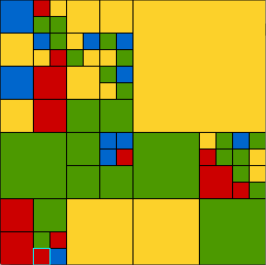
Each player is randomly assigned their own goal to work towards: either to create the largest connected “blob” of a given color or to put as much of a given color on the outer perimeter as possible.
There are three kinds of moves a player can do:
. rotating a block (clockwise or counterclockwise),
. reflecting the block horizontally or vertically (i.e. along the x-axis or they-axis if you imagine
the origin of the axes being place in the center of the block), and
. “smashing” a block (giving it four brand-new, randomly generated, sub-blocks).
After each move, the player sees their score, determined by how well they have achieved their goal. The game continues for a certain number of turns, and the player with the highest score at the end is the winner.
The Game Board
We will call the game board a “block”. Blocks can be recursively defined; a block is either:
. a square of one color, or
. a square that is subdivided into 4 equal-sized blocks.
The largest block of all, containing the whole structure, is called the top-level block. We say that the top-level block is at level 0 (i.e. it would be at the root of the quad-tree used to represent it). If the top-level block is subdivided, we say that its four sub-blocks are at level 1 (i.e. these would correspond to the children of the root in the aforementioned quad-tree). More generally, if a block at level k is subdivided, its four sub-blocks are at level k + 1.
A board will have a maximum allowed depth, which is the number of levels down it can go. A board with maximum allowed depth 0 would not be fun to play on since it couldn’t be subdivided beyond the top level, meaning that it would be of one solid color. The following board was generated with maximum depth 5:
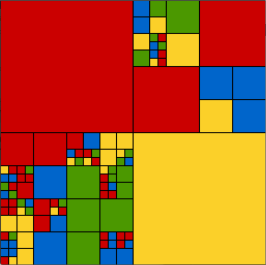
For scoring, the units of measure are squares the size of the blocks at the maximum allowed depth. We will call these blocks unit cells.
Moves
To achieve their goal, the players are allowed the three type of moves described above. Note that, smashing the top-level block is not allowed, since that would be creating a whole new game. And smashing a unit cell is also not allowed, since it’s already at the maximum allowed depth. What makes moves interesting is that they can be applied to any block at any level. For example, if the player selects the entire top-level block (highlighted) for this board

and chooses to rotate it counter-clockwise, the resulting board would be the following:
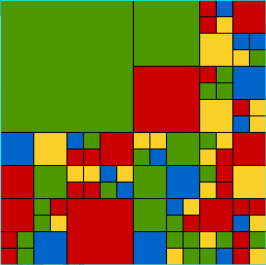
But if instead, on the original board, they choose to rotate (still counter-clockwise) the block at level 1 in the upper left-hand corner, then the resulting board would be the following:

Finally, if instead they choose to rotate the block a further level down, still sticking to the upper-left corner, they would get this:

Of course, the player could have chosen many other possible blocks on the board and they could have decided to perform a different type of move.
Goals and Scoring
At the beginning of the game, each player is assigned a randomly-generated goal. There are two types of goal:
. Blob goal. The player must aim for the largest “blob” of a given color c. A blob is a group of orthogonally connected blocks with the same color. That is, two blocks are considered connected if their sides touch; touching corners does not count. The player’s score is the number of unit cells in the largest blob of color c.
. Perimeter goal. The player must aim to put the most possible units of a given color c on the outer perimeter of the board. The player’s score is the total number of unit cells of color c that are on the perimeter. There is a premium on corner cells: they count twice towards the score.
Notice that both goals are relative to a particular color. We will call that the target color for the goal.
PART - 0: Familiarize yourself with the starter code
Let’s start by getting comfortable with the code provided and the idea behind the block data structure.
As mentioned in the introduction, we will be using a quad-tree to represent the structure of a block. Quad-trees are trees in which each internal node has exactly four children. It would not make sense for us to use a tree in which nodes could have a different number of children, say three. This is because a block is either solid-colored or subdivided; if it is solid-colored, it is represented by a node with no children (i.e. a leaf), and if it is subdivided, it is subdivided into exactly four sublocks.
Open the Block. java file and familiarize yourself with the provided code in this class. Note that the class has the following fields:
. Two ints, xCoord and yCoord, representing the coordinates of the upper left corner of this Block. Note that the origin, (0, 0), is the top left corner of the window, and the window has the following coordinates:

. An int size representing the height and width of this Block. Since all blocks are square, one variable is enough to represent both.
. An int level representing the level of this Block within the overall block structure. The top-level block, corresponding to the root of the tree, is at level 0. As already noted, if a block is at level i, its children will be at level i + 1.
. An int maxDepth representing the deepest level allowed in the overall block structure.
. A Color color. If this block is not subdivided (i.e. if it is a leaf), then this field stores its color. Otherwiwse, this field should be null.
. A Block[] children representing the blocks into which this block is subdivided. The children are stored in this order: upper-right child, upper-left child, lower-left child, lower-right child. If this Block has no children, then this field should store a reference to an array of length 0.
Before beginning to write your own code to complete the implementation of this class, let’s get more comfortable with the Block structure. Start by drawing on paper the quad-tree representing game board from Figure 1 (assuming the maximum depth is 2):
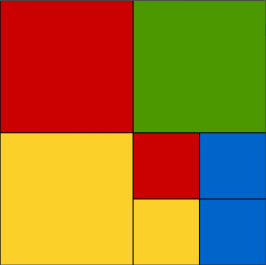
Figure 1: A Block with max depth 2
Each node should contain the values that would be assigned to their corresponding Block objects. You can assume that the size of the top-level block is 16. How many nodes have you drawn?
NOTE: If you come to office hours, we will ask to see your drawing before answering questions!
Now that you can draw the block structure on paper, can you translate it into code? Inside the main method of the Block class, create a Block object that corresponds to the same game board above. You can access constants representing the Colors needed from the class GameColors. Once you have created the board, you can display its text representation using the method printBlock() provided to you. If the structure has been created correctly the following should be displayed:
pos=(0,0), size=16, level=0
GREEN, pos=(8,0), size=8, level=1
RED, pos=(0,0), size=8, level=1
YELLOW, pos=(0,8), size=8, level=1
pos=(8,8), size=8, level=1
BLUE, pos=(12,8), size=4, level=2
RED, pos=(8,8), size=4, level=2
YELLOW, pos=(8,12), size=4, level=2
BLUE, pos=(12,12), size=4, level=2
Invariants. While thinking about the block structure, you might have noticed that each nodes must satisfy a lot of invariants for the tree to correctly represent a Block. Here is a list of some of them:
. Nodes have either 4 children or 0.
. If this Block has children then:
– their maxDepth is the same as the one of this Block
– their size is half that of this Block
– their level is one greater than that of this Block
– the position of their upper left corner can be determined from their size and the position of the upper left corner of this Block (I’ll leave it up to you to figure out how).
– the color of this Block is null
. level is always smaller than or equal to maxDepth
TEST and DEBUG. Please note that to test and debug your code you should not rely on the GUI. The GUI can definitely help fine tune your code, but you should test and debug it before using it. The method printBlock() provided to you displays a text representation of the block and can help you through this process. Remember that you are allowed and encouraged to add as many private helper methods as you wish. This will help you to: keep your code cleaner and better organized, as well as break each task into smaller steps. All of this will in turn help you when testing and debugging.
PART - I: Set up the board (30 points)
With a good understanding of the data structure, you are now ready to start working on the completion of the class Block.
[10 points] For the game, we want to be able to generate random boards. This is what the constructor Block(int lvl, int maxDepth) is for. The method generates a random Block with level lvl, and maximum depth maxDepth using the following the strategy: if a Block is not yet at its maximum depth, it can be subdivided. Decide whether or not to do so as follows:
. Use the Random object stored in the field gen to generate a random number in the interval [0, 1). Please note that you should generate this number if and only if it is possible for this Block to be subdivided.
. Subdivide the block if the random number is less than Math. exp(-0.25 * level), where level is the level of the Block within the tree.
. If a Block is not going to be subdivided, use a random integer to pick a color for it from the array of colors in GameColors. BLOCK COLORS![]() . Make sure to generate the integer in the appropriate range, and use gen to do so.
. Make sure to generate the integer in the appropriate range, and use gen to do so.
Notice that the randomly-generated Block may not reach its maximum allowed depth. It all depends on the random numbers generated.
This constructor is responsible for assigning the appropriate values to the fields of all Blocks within the Block it generates except the fields size, xCoord, and yCoord which should be instead initialized by default. Next, you will write a method that can be used to correctly initialize all these fields.
If you use the seed 2 when initializing the Random variable gen on line 17 of Block. java, then when executing the following snippet of code
Block blockDepth2 = new Block(0,2);
blockDepth2.printBlock();
the text below will be displayed:
pos=(0,0), size=0, level=0
GREEN, pos=(0,0), size=0, level=1
RED, pos=(0,0), size=0, level=1
YELLOW, pos=(0,0), size=0, level=1
pos=(0,0), size=0, level=1
BLUE, pos=(0,0), size=0, level=2
RED, pos=(0,0), size=0, level=2
YELLOW, pos=(0,0), size=0, level=2
BLUE, pos=(0,0), size=0, level=2
[10 points] Implement the method updateSizeAndPosition(). This method takes three integers as input: one representing the size of this block, and the others representing the coordinates of the upper left corner of this block. The method updates the size and position for this block and all of its sub-blocks, while ensuring consistency between the values of the fields and the relationship of the blocks. Make sure the invariants are all respected! The method should throw an IllegalArgumentException is the input for the size is invalid, i.e. if it is negative or it cannot be evenly divided into 2 integers until the max depth is reached. There’s no need to perform any input validation for the coordinates.
If you use the seed 2 when initializing the Random variable gen on line 17 of Block. java, then when executing the following snippet of code
Block blockDepth2 = new Block(0,2);
blockDepth2. updateSizeAndPosition(16, 0, 0);
blockDepth2.printBlock();
the text below will be displayed:
pos=(0,0), size=16, level=0
GREEN, pos=(8,0), size=8, level=1
RED, pos=(0,0), size=8, level=1
YELLOW, pos=(0,8), size=8, level=1
pos=(8,8), size=8, level=1
BLUE, pos=(12,8), size=4, level=2
RED, pos=(8,8), size=4, level=2
YELLOW, pos=(8,12), size=4, level=2
BLUE, pos=(12,12), size=4, level=2
[10 points] In order for the game to be able to draw the blocks you can now generate, you need to provide an implementation for the method getBlocksToDraw(). The method returns an ArrayList of BlockToDraws. Open the file BlockToDraw. java to familiarize yourself with this data type. The list returned by getBlocksToDraw() should contain, for each undivided Block:
. one BlockToDraw in the color of the block
. another BlockToDraw in the FRAME COLOR (see GameColors. java) and a stroke thickness![]() equal to 3.
equal to 3.
Note that a stroke thickness equal to 0 indicates that the block should be filled with its color. The order in which the objects BlockToDraw appear in the list does not matter.
After having implemented this method, you can try to run BlockGame. If you use the seed 2 when initializing the Random variable gen on line 17 of Block. java and you select 2 as the maximum depth when running the game, you will see the following board displayed:
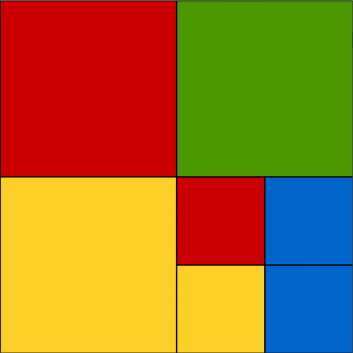
As you might have noticed, this is the same Block from Figure 1.
PART - II: Make the game playable (30 points)
Time to make the game real by allowing players to be able to select a block from the board and apply a move of their choice.
[12 points] The first thing to do is implement the method getSelectedBlock() which allows the game to retrieve the Block selected by the player. In order for the user to play the game, they must be able to select a block on which they would like to make a move. They will do so by clicking on the board at a desired location, and using the up and down arrows to choose the level of the block. The method getSelectedBlock() takes those inputs (the (x,y) coordinates of where the user clicked, and an int representing the level selected), and finds the corresponding Block within the tree. If the level specified is lower than the lowest block at the specified location, then the method returns the block at the location with the closest level value. Note that if a Block includes the location (x,y), and that Block is subdivided, then one of its sub-Blocks will contain the location (x,y) too. This is why the level is needed to identify which Block should be returned. Please note that you can view the quad-tree representing the block data structure as a search tree. As such, this method should run in O(h), where h is the height of the tree.
Input validation: if the level provided is smaller than this Block’s level or larger than its maximum depth, then the method should throw an IllegalArgumentException. If the position, (x,y), is not within this Block, then the method should return null.
For example, using the seed 4 when initializing the Random variable gen online 17 of Block. java, the following snippet of code generates a board with maximum depth 3, top left corner in position (0, 0), and size equal to 16.
Block blockDepth3 = new Block(0,3);
blockDepth3. updateSizeAndPosition(16, 0, 0);
We can then select and print the Block at level 1 containing the location (2 , 15) as follows:

Please note, that the same would have been displayed even if the level selected was 2 or 3. On the other hand, we can select and print the Block at level 2, containing the location (3 , 5) as follows:

[6 points] Implement the method reflect(). The method takes an int as input representing whether this Block should be reflected over the x-axis (if the input is 0) or the y-axis (if the input is 1). When thinking about performing a reflection of this Block, you can think of the origin of the axes being placed in the center of this Block. To successfully perform a reflection, the same operation should be propagated to all the sub-blocks of this Block. Make sure that the method correctly updates all the necessary fields. The method throws an IllegalArgumentException if the integer received as input is neither a 0 nor a 1.
For example, using the seed 4 when initializing the Random variable gen online 17 of Block. java, let’s generate aboard with maximum depth 3. In Figure 2, you can see the effect of a reflection over the x-axis of either the top-level block or the level 1 block on the top-left corner.

Figure 2: Left: Original board. Center: Board after reflection on top-level block. Right: Board after reflection on the level 1 top-left block.
[6 points] Implement the method rotate(). The method takes an int as input representing whether this Block should be rotated counter-clockwise (if the input is 0) or clockwise (if the input is 1). The operation should be propagated to all of its sub-blocks. If this Block has no children, then the method should not do anything. Make sure that the method correctly updates all the necessary fields. You can throw an IllegalArgumentException if the integer received as input is neither a 0 nor a 1.
For example, using the seed 4 when initializing the Random variable gen online 17 of Block. java, let’s generate aboard with maximum depth 3. In Figure 3, you can see the effect of a clockwise rotation of either the top-level block or the level 1 block on the top-left corner.

Figure 3: Left: Original board. Center: Board after a clockwise rotation of the top-level block. Right: Board after a clockwise rotation of the level 1 top-left block.
[6 points] Implement the method smash(). This method takes no inputs and, if this Block can be smashed, it randomly generates four new sub-blocks for it. If the Block already had children, they will be discarded. Make sure that the method correctly updates all the necessary fields. Remember that a Block can be smashed if and only if it is not the top-level Block and it is not already at a level equal to the maximum depth. The method returns true if this Block was smashed and false otherwise.
For example, using the seed 4 when initializing the Random variable gen online 17 of Block. java, let’s generate a board with maximum depth 3. In Figure 4, you can see the effect of smashing the level 1 block on the top-left corner or the effect of smashing the level 2 block on the top-left corner.

Figure 4: Left: Original board. Center: Board after smashing the level 1 top-left block. Right: Board after smashing the level 2 top-left block.
2024-03-25